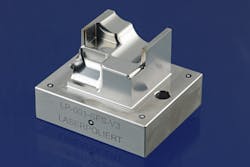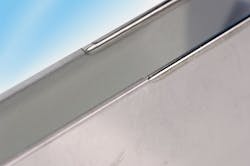A team of researchers at the Fraunhofer Institute for Laser Technology (Fraunhofer ILT; Aachen, Germany) is investigating laser polishing for tribologically stressed surfaces, sealing surfaces, and laser deburring of sheet edges. Deburring and polishing are becoming increasingly important in metalworking, as the processes are particularly advantageous for functional surfaces and demanding deburring tasks.
In laser deburring of sheet metal parts, continuous-wave (CW) lasers are the preferred choice for this application due to their ability to remove burrs and sharp edges quickly and reliably—in some cases, at a rate of several meters per minute—and to mold the part into the required shape by remelting. Users can harness this melting process to create a defined shape—for example, by rounding off the part smoothly and evenly.
Laser polishing techniques for metal surfaces make use of both CW and pulsed lasers. Pulsed lasers with pulse durations of a few hundred nanoseconds and a remelt depth of several micrometers are a popular choice for machining ground surfaces with low roughness, for example. In contrast, CW lasers capable of achieving remelt depths up to 100 µm are a good choice for rougher surfaces, such as those formed by milling or erosion machining.
For metal surfaces, polishing rates of 1 to 60 s/cm2 are achieved. The exact figure depends on the application and laser power in each case. “We’re already seeing some interesting applications in the automotive and mechanical engineering sectors, as well as in precision mechanics and medical devices,” says Dr. Edgar Willenborg, manager of the Laser Polishing group at Fraunhofer ILT. “Laser polishing is particularly suitable for surfaces exposed to high tribological stress, as well as for sealing surfaces and, in some cases, for areas that are difficult to access using conventional methods.”
Another advantage of this method is that it can be used with many different materials, including various types of steel and some cast alloys, as well as nickel, titanium, and cobalt-chrome alloys and even pure titanium.
Laser polishing is still relatively rare in industrial manufacturing. Nevertheless, the first applications are already implemented and have proven to be both cost-effective and technically viable. At Fraunhofer ILT, a dedicated research group consisting of seven scientists is working intensively on this still young topic. Though modest in size, Willenborg, who is leading the work, believes this may be the world’s biggest research group focused specifically on laser polishing.Lasers can even be used to process complex, three-dimensional parts. Working in collaboration with a special-purpose machine maker, Fraunhofer ILT has developed a machine technology the scientists use to continue developing and testing laser polishing for new applications. “The technology has lived up to its promise on a laboratory scale, and now we’re close to seeing the first industrial applications,” says Willenborg. “Laser polishing primarily caters to medium levels of quality—for example, to achieve technical functionalization with a high degree of automation.” When it comes to mirror-like, high-gloss surface finishes, he adds, laser polishing is not generally such a good choice.
Willenborg reports that high demand for new polishing techniques has boosted interest in laser polishing across the board, noting that this method also offers the advantage of being easy to integrate in existing production lines for smaller parts.
Willenborg and his team will present further details on laser deburring and polishing at the Fraunhofer ILT booth (booth #319, hall 1) in the Research Pavilion at the Deburring EXPO, to take place October 8-10, 2019, in Karlsruhe, Germany.

